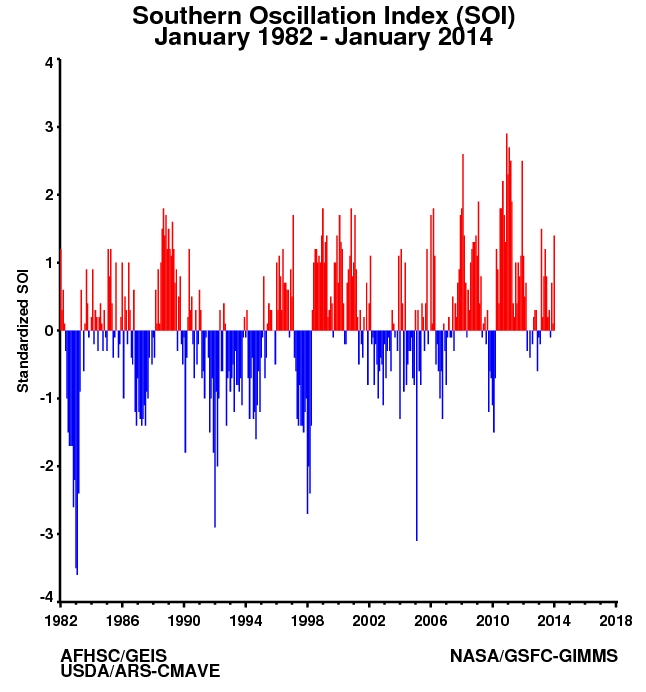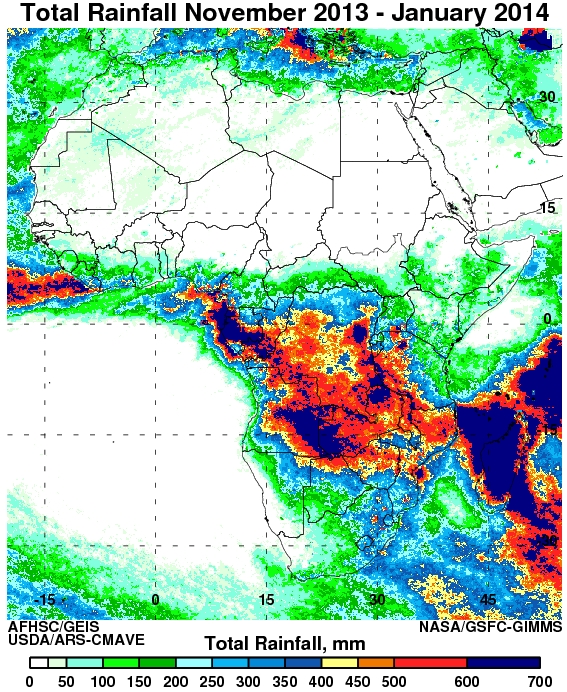
This section of the report will provide a rolling three month update on a monthly basis of the state of the climatic and ecological indicators used in monitoring areas at risk to RVF activity. These indicators include, global SST anomalies patterns, Equatorial Western Indian Ocean (WIO) and Eastern Pacific Ocean (EPO: NINO 3.4) SST anomalies, Southern Oscillation Index (SOI) and Outgoing Longwave Radiation (OLR) anomalies, Rainfall and anomalies, Normalized Difference Vegetation index anomalies and RVF risk map for Africa and the Arabian Peninsula.
January 2014
1. SOI and SST Indices


The SOI index decreased to negative values in January 2014 at -1.5 from 0.3 in December, reflecting recent basin wide cooling as a result of a dip oceanic heat content and below-average subsurface temperatures at depth across the eastern Pacific. Correspondingly, January monthly SST anomalies in the NINO3.4 SST region are also negative at ~ -0.5°C and so are the WIO SST (0.01°C) anomalies indicating cooling conditions over these ocean basins. Even with the recent cooling conditions, nearly all model forecasts indicate the persistence of ENSO-neutral (Niño-3.4 index between -0.5°C and 0.5°C) through the Northern Hemisphere spring 2014, but afterwards, an increasing number of models suggest the possible onset of El Niño.


The eastern equatorial Pacific Ocean a pattern of below normal SSTs in the region from 90°W to 150°W [NINO1.2 region] during the November 2013 to January 2014 period with SST anomaly values in the range of -0.5°C to -2.0°C. In contrast the entire western equatorial Pacific continues to show the persistence of above normal SST (0.5°C to 2.0°C) for the last three months. Accordingly, the equatorial Indian Ocean between 30°S and the equator is also dominated by positive SST anomalies with a strong cell of persistent positive anomalies ~ +3.0°C located at 30°S east of Madagascar over the last few months. Other regions of significant anomalies include the north Pacific Ocean, north Atlantic, the Pacific Ocean off the California coast, and south Indian Ocean off the southern Africa landmass which show significant positive and negative anomalies on the order of -/+1.0°C to -/+2.0°C. Outgoing Longwave Radiation (OLR) anomalies are used here as a proxy for tropical deep convection (rainfall). Reduced convection is shown in yellow to light brown and brown shades and increased/intense convection is shown by shades of blue. Some impacts from the SST anomaly patterns can be observed in the pattern of global convective activity illustrated by the OLR departure patterns here. During the November 2013 to January 2014 period, drier-than-average conditions are observed over the equatorial eastern Pacific Ocean between 180W and 150W, eastern Australia region and over California, which undergoing a severe drought at present with high positive OLR anomalies (+50W/M2). Convective activity continues to be prevalent over parts of Southeast Asia, equatorial West Africa extending to SW Africa (-50W/M2). These patterns of depressed and enhanced convective activity coincide well with the pattern of SST departures. Monthly and weekly anomalies can be
found here. Rainfall and associated anomalies (below) for Africa from November 2013 to January 2014 show rainfall concentrated from ~5°N southwards indicating a shift of the rainfall producing mechanisms into the southern hemisphere. Areas of above normal (+50 to +250mm) rainfall include including the Gulf of Guinea and confluence border region of Angola, Botswana, Zambia and Zimbabwe.


Cumulative NDVI anomalies for Africa for November 2013 to January 2014 show positive anomalies concentrated over the Horn Africa from the above normal rainfall from over the last 3 months. The RVF risk map below was derived from thresholding NDVI anomaly data to detect areas persistent of above normal NDVI. Periods of widespread and prolonged heavy rainfall lead to flooding of dambos and anomalous green up in vegetation, creating ideal ecological conditions for the emergence RVF vectors. For the period November 2013 to January 2014, the RVF persistence model to identify isolated areas in central Somalia, SW Ethiopia and north-central Kenya where ecological conditions would support the emergence of RVF vectors.






















